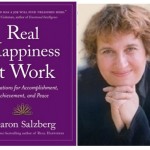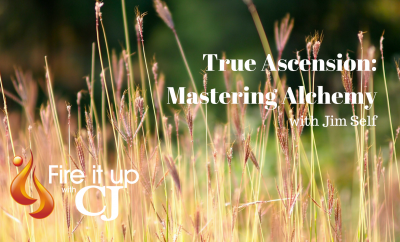
Buddhism & Taoism
Mindfulness: Real Happiness at Work (Sharon Salzberg)
How could mindfulness at work change our experience at work? A mindfulness practice at work helps you step back and effectively short circuits a potential reactive fight-or-flight conditioning and allows us to be more resourceful and creative in problem solving and communication. Plus, it can increase our personal productivity and quality of our work. Join CJ as she talks to one of the preeminent teachers of Buddhist meditation and NY Times best selling author, Sharon Salzberg, about her newest book “Real Happiness at Work: Meditations for Accomplishment, Achievement, and Peace”. Get some practical tips on introducing mindfulness at work.
Real Happiness at Work: Meditations for Accomplishment, Achievement, and Peace
- Part 1: Sharon walks us through how mindfulness could create more productive results in resolving conflicts with work associates
- Part 2: Sharon Salzberg offers some thoughts on how to deal with a constant barrage of distractions, and building stronger communication via email and meetings.
- Part 3: What kinds of organizations are successfully introducing mindfulness into their corporate culture? What evidence is there that mindfulness translate to profits and productivity?
- Part 4: A Buddhist take on other spiritual practices out there.
Blog Post by our Sharon Salzberg
Real Happiness At Work: The Myth Of Multitasking
The following is excerpted from Real Happiness at Work: Meditations for Accomplishment, Achievement, and Peace
We would like to believe that attention is infinite, but it isn’t. That is why multitasking is a misnomer. The brain can focus only on one thing at a time. We take in information sequentially. When we attempt to focus on multiple tasks simultaneously, what actually happens is that we switch back and forth between tasks, paying less attention to both. This does not mean that we can’t walk and chew gum at the same time, of course. What we cannot do is concentrate in the same moment on two distinct, input-rich activities that require our attention. While we may be able to talk on the phone and stir coffee simultaneously, we can’t carry on a conversation and text at the same time without losing information and time. Studies show that when people are interrupted and have to switch their attention back and forth, they take–on average–50 percent longer to accomplish the task and make up to 50 percent more errors. That’s because each time you switch tasks, your brain has to run through a complex process to disengage the neurons involved in one task and activate the neurons needed for the other. The more you switch back and forth, the more time you waste and the lower your quality of work.
Strung out by information overload, however, many of us are becoming habituated and addicted to distraction. “Successful” multitasking has been shown to activate the reward circuit in the brain by increasing dopamine levels–the brain chemical responsible for feelings of happiness. The danger of this is that the dopamine rush feels so good that we don’t notice we’re making more mistakes. This is comparable to the rush you might feel while playing the slot machines in a casino. Stimulated and entertained by the flashing lights, the ringing bells, and the distracting, carnival-like atmosphere, gamblers go into a pleasure trance, addicted to the illusion of winning money when, in fact, they’re going broke. It’s important to be aware of how multitasking can stimulate us into mindlessness, giving the illusion of productivity while stealing our focus and harming performance. “When you are walking, walk. When you are sitting, sit,” is ancient wisdom. Hopping rapidly from one thing to the next, answering the phone while we’re shuffling papers while we’re sipping a latte, we fritter away our attention and forget more easily. In addition to dopamine, multitasking prompts the release of adrenaline and other stress hormones, which contribute to short-term memory loss as well as long-term health problems. This also means that the information we take in while multitasking is harder to retrieve later than information we take in while concentrating. That is why learning to be a unitasker in a multitasking world is so vital.
Rather than divide our attention, it is far more effective to take frequent breaks between intervals of sustained, one-pointed attention. A Web designer named Brian figured this out for himself with no knowledge of neuroscience. “I work for a community news site and have to be online from nine to five,” Brian says. “It can really fry the brain and get tedious. I’ve found that if I take ten minutes or so for every hour of work to do something for myself, like read somebody’s blog or take a walk, it helps me concentrate when I turn back to my duties.” Although this may sound difficult, Brian’s increased focus enables him to return to the task at hand with surprising ease. “Instead of hopping from thing to thing–which is so tempting with the Internet–I focus on what’s in front of me. Then I let myself dillydally to give my brain a rest. When it comes to work, less is definitely more in terms of feeling satisfied. And efficient.” While this may sound counterintuitive, relaxing our focus for regular intervals and pacing our sustained concentration sharpens attention and renders the mind more flexible.
Debunking the myth of multitasking, we become much better at what we do and increase the chance of being able to remember the details of work we have done in the past.We would like to believe that attention is infinite, but it isn’t. That is why multitasking is a misnomer. The brain can focus only on one thing at a time. We take in information sequentially. When we attempt to focus on multiple tasks simultaneously, what actually happens is that we switch back and forth between tasks, paying less attention to both.
Follow Sharon Salzberg on Twitter: www.twitter.com/sharonsalzberg
About Sharon Salzberg
 http://www.sharonsalzberg.com/ || Born in New York City in 1952, Sharon Salzberg experienced a childhood involving considerable loss and turmoil. An early realization of the power of meditation to overcome personal suffering determined her life direction. Her teaching and writing now communicates that power to a worldwide audience of practitioners. She offers non-sectarian retreat and study opportunities for participants from widely diverse backgrounds.
http://www.sharonsalzberg.com/ || Born in New York City in 1952, Sharon Salzberg experienced a childhood involving considerable loss and turmoil. An early realization of the power of meditation to overcome personal suffering determined her life direction. Her teaching and writing now communicates that power to a worldwide audience of practitioners. She offers non-sectarian retreat and study opportunities for participants from widely diverse backgrounds.
Sharon first encountered Buddhism in 1969, in an Asian philosophy course at the State University of New York, Buffalo. The course sparked an interest that, in 1970, took her to India, for an independent study program. Sharon traveled motivated by “an intuition that the methods of meditation would bring me some clarity and peace.”
In 1971, in Bodh Gaya, India, Sharon attended her first intensive meditation course. She spent the next years engaged in intensive study with highly respected Buddhist teachers. She returned to America in 1974 and began teaching vipassana (insight) meditation. Today she leads intensive retreats worldwide as well as a variety of
non-residential programs, workshops, and classes.
In 1976, she established, together with Joseph Goldstein and Jack Kornfield, the Insight Meditation Society (IMS) in Barre, Massachusetts, which now ranks as one of the most prominent and active meditation centers in the Western world. Sharon and Joseph Goldstein expanded their vision in 1989 by co-founding the Barre Center for Buddhist Studies (BCBS). In 1998, they initiated the Forest Refuge, a long-term retreat center secluded in a wooded area on IMS property. Sharon resides in Barre, Massachusetts, and New York City.
Sharon has also emerged as a featured speaker and teacher at a wide variety of events. She served as a panelist with the Dalai Lama and leading scientists at the 2005 Mind and Life Investigating the MindConference in Washington, DC. She also coordinated the meditation faculty for the 2005 Mind and Life Summer Institute, an intensive five-day meeting to advance research on the intersection of meditation and the cognitive and behavioral sciences.
At the 2005 Sacred Circles Conference at the Washington National Cathedral, Sharon served as a keynote speaker. She has addressed audiences at the State of the World Forum, the Peacemakers Conference (sharing a plenary panel with Nobel Laureates His Holiness the Dalai Lama and Jose Ramos Horta) and has delivered keynotes at Tricycle’s Buddhism in AmericaConference, as well as Yoga Journal, Kripalu and Omega conferences. She was selected to attend the Gethsemani encounter, a dialogue on spiritual life between Buddhist and Christian leaders that included His Holiness the Dalai Lama.
The written word is central to Sharon Salzberg’s teaching and studies. In her early Buddhist studies at the University of Buffalo, she discovered Chogyam Trungpa’s book, Meditation in Action. She later heard him speak at a nearby school: he was the first practicing Buddhist she encountered. While studying in India, Shunryu Suzuki’s book Zen Mind, Beginner’s Mindprofoundly influenced the direction of her meditation practice.
She is a regular contributor the the Huffington Post, and was a contributing editor of Oprah’s O Magazine for several years. She has appeared in Time Magazine, Yoga Journal, msnbc.com, Tricycle, Real Simple, Body & Soul, Mirabella, Good Housekeeping, Self, Buddhadharma, More and Shambhala Sun, as well as on a variety of radio programs.
Various anthologies on spirituality have featured Sharon Salzberg and her work, including Meetings with Remarkable Women, Gifts of the Spirit, A Complete Guide to Buddhist America, Handbook of the Heart, The Best Guide to Meditation, From the Ashes—A Spiritual Response to the Attack on America, and How to Stop the Next War Now: Effective Responses to Violence and Terrorism.
#Sharon Salzberg, Mindfulness, Peace of mind, sharon salzberg meditation, salzberg, susan salzberg, buddhism, sharon saltzberg, youtube sharon, sharon youtube, sharon sangha,sharon joseph, sharon chopra, Real Happiness at Work: Meditations for Accomplishment, Achievement, and Peace, insight meditation society , mindfulness, insight meditation






